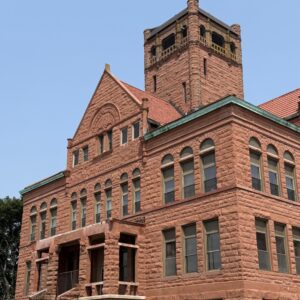Landmarks Illinois has announced its 2024 Most Endangered Historic Places in Illinois, which calls attention to 10 culturally and architecturally significant sites across the state that are desperately in need of preservation resources.
“This year’s ‘Most Endangered’ sites are not only incredibly important places in their communities, but many are large-scale buildings that sit prominently in highly visible areas near city centers, in historic districts or on state-owned land. Their neglect is seen and felt,” said Bonnie McDonald, President & CEO of Landmarks Illinois.
“Despite their current condition, these places tell important stories from our past — stories that should not be erased due to insufficient investment or general disregard for our collective histories. Landmarks Illinois stands ready and willing to help our partners find preservation resources and solutions for these threatened places, which are opportunities for sustainable reuse, job creation and providing spaces needed in their communities.”
2024 Most Endangered sites
The 2024 Most Endangered sites are located in the following counties: Cook, Gallatin, Henry, Johnson, Macon, Madison, Pope and St. Clair. Visit our website to learn more about each site. A digital press packet, which includes local contacts for each endangered property, is also available on our website.
BISHOP HILL COLONY CHURCH
Bishop Hill, Henry County
Built in 1848, this Colony Church is among the surviving original buildings in the Village of Bishop Hill, one of the earliest settlements of Swedish immigrants in the United States. It is also one of three Illinois State Historic Sites included on our 2024 Endangered List. It is threatened since the Illinois Department of Natural Resources has not been provided with sufficient funding to properly maintain the site.
BUEL HOUSE STATE HISTORIC SITE
Golconda, Pope County
The Alexander Buel House, constructed in 1840, is a state historic site with ties to the Trail of Tears. Like other Illinois State Historic Sites included on our 2024 Endangered List, the house suffers from deferred maintenance due to a lack of state resources. The state recently painted the exterior of the house, but other repairs are desperately needed, including urgent interior work.
SHAWNEETOWN BANK STATE HISTORIC SITE
Old Shawneetown, Gallatin County
Shawneetown Bank State Historic Site is home to the former Bank of Illinois, the oldest bank building in the state. Landmarks Illinois previously listed the landmark structure on the 2009 Most Endangered list due to insufficient maintenance. Today, it has fallen into further disrepair. As is the case with other Illinois State Historic Sites included on the 2024 Most Endangered list, budgetary concerns place this property in danger of continued neglect.
LIBBY, MCNEILL AND LIBBY BUILDING
Blue Island, Cook County
The former canning and bottling factory was built in 1918 for the Libby, McNeill and Libby company, the second-largest producer of canned foods in the country at the time. For decades, the factory was an economic engine for the community, employing hundreds of local residents and migrant workers, until it closed in 1968. The building is currently vacant and is beginning to decay due to a lack of reuse and proper maintenance.
PORTAGE THEATER
Chicago, Cook County
The prominent theater, completed in 1920 near Portage Park’s popular “Six Corners” area, has been an important cultural institution for the local community. However, it has suffered from deferred maintenance since fully closing in 2018. While the current owner has demonstrated interest in revitalizing the designated Chicago Landmark, long-term plans remain unclear and securing financing has been a challenge.
SEARS ADMINISTRATION BUILDING
Chicago, Cook County
Constructed in two phases in 1905 and 1914, the Administration Building served as office headquarters for the former retail giant, Sears, Roebuck and Co., until the 1970s. It is part of the company’s sprawling campus in the city’s North Lawndale neighborhood, a complex that is a designated National Historic Landmark and is a Chicago landmark district. The building has been on the market since the spring of 2023. And, unlike other buildings on the Sears campus that have been rehabilitated and adaptively reused, this one sits vacant and underutilized despite its potential.
FORMER COLLINSVILLE TOWNSHIP HIGH SCHOOL
Collinsville, Madison County
The former Collinsville Township High School welcomed generations of students between 1908 and 1982 and has had various uses since, but today sits empty and deteriorating in a prominent part of the Southern Illinois city. The current owner has plans to develop the building into affordable housing and has identified funding and tax incentives to do so. Local officials, however, oppose the project, which means that the school may continue to sit vacant indefinitely.
DECATUR MASONIC TEMPLE
Decatur, Macon County
The Decatur Masonic Temple has served as an important community center in Decatur’s historic district since it was built in 1929. Throughout the past nearly 100 years, it has hosted cultural events and famous speakers like Eleanor Roosevelt and John F. Kennedy Jr. The building has suffered deterioration and does not generate enough income today to pay for proper maintenance, leading to expensive damages.
FORMER LINCOLN SCHOOL
East St. Louis, St. Clair County
Built in 1886 as a school for Black students, the historically significant building has survived the 1917 East St. Louis Race Riots and the widespread demolition seen in the Southern Illinois city during the mid-20th century. Despite its local importance and proximity to the city’s historic district, without a new use and proper investment, the school faces demolition.
JOHNSON COUNTY COURTHOUSE
Vienna, Johnson County
Built in 1871, the Johnson County Courthouse was the oldest continually operating courthouse in Illinois before it closed in 2023. While a new county complex is being constructed to house county offices, the nationally landmarked courthouse was supposed to be repurposed for local businesses and other governmental work. However, it has sat vacant since September 2023 when a roof truss fractured. Until funding for permanent stabilization is secured, the future of the building remains uncertain.
About the Most Endangered Program
The annual Most Endangered Historic Places in Illinois is Landmarks Illinois’ largest and longest-running advocacy program. Launched in 1995, the annual list aims to boost advocacy efforts and build support for each property’s eventual preservation. Learn more about our Most Endangered Historic Places in Illinois and see previous Most Endangered lists at our website.
About Landmarks Illinois
We are People Saving Places for People. Landmarks Illinois is a membership-based, historic preservation nonprofit organization serving the people of Illinois. We inspire and empower stakeholders to save places that matter to them by providing free guidance, practical and financial resources and access to strategic partnerships. For more information, visit www.Landmarks.org.
***Courtesy of Kaitlyn McAvoy, Director of Communications Landmarks Illinois***







